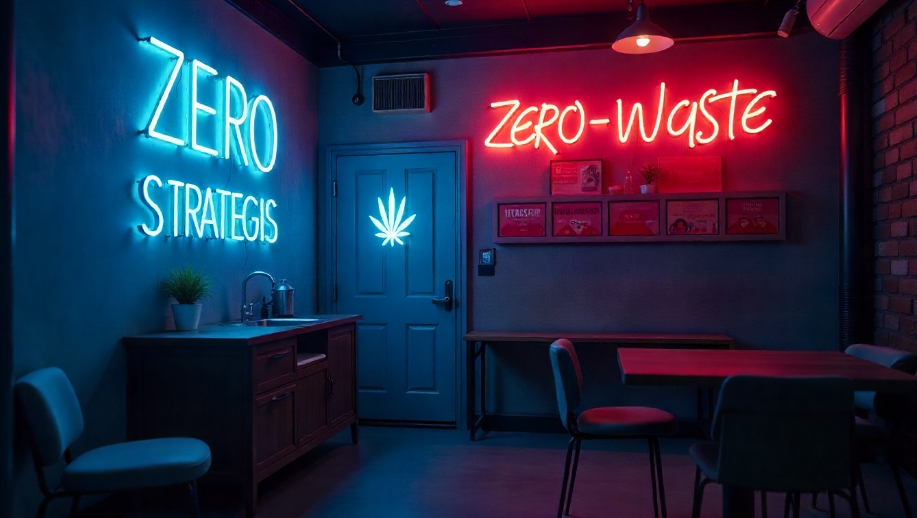Sustainability isn’t just a buzzword in Canada’s cannabis sector—it’s becoming a business necessity. With growing environmental regulations, consumer awareness, and the unique waste challenges of cannabis production, companies are under increasing pressure to adopt zero-waste strategies. This approach not only reduces ecological impact but also enhances brand credibility in a competitive market.
Below, we’ll explore practical, innovative, and regulatory-compliant strategies that cannabis producers, retailers, and delivery services in Canada can use to move toward a zero-waste future.
1. Understanding the Zero-Waste Concept in Cannabis
Zero-waste in the cannabis industry aims to minimize landfill contributions by reducing, reusing, recycling, and composting all possible materials. Given that cannabis production involves multiple waste streams—organic plant matter, packaging, water runoff, and more—creating a zero-waste system requires:
- Comprehensive waste audits to identify where waste is generated.
- Regulatory compliance with Health Canada’s strict cannabis waste disposal rules.
- Collaboration with specialized recyclers for non-traditional waste streams.
When implemented effectively, zero-waste practices can lower operational costs, improve sustainability scores, and align with eco-conscious consumer values.
2. Packaging Innovations and Recycling Programs
Excess packaging remains one of the most criticized aspects of the Canadian cannabis industry. Many products are overpackaged due to child-resistant requirements, leading to unnecessary plastic and cardboard waste.
Solutions:
- Compostable packaging made from hemp, cornstarch, or mushroom mycelium.
- Reusable containers with return incentives for customers.
- Partnerships with recycling programs like TerraCycle to handle materials not accepted in municipal recycling streams.
Innovative cannabis brands are also incorporating digital labeling via QR codes, which reduces the need for printed inserts while giving consumers more product information.
3. Waste Reduction in Cannabis Cultivation
Cannabis cultivation produces a significant amount of organic waste, including stalks, leaves, and expired plants. Traditional disposal methods like landfill dumping or incineration are neither sustainable nor cost-effective.
Strategies for zero-waste cultivation include:
- Composting plant waste for reuse in soil enrichment.
- Converting biomass into hemp-based products like textiles or biodegradable plastics.
- Closed-loop irrigation systems recycle water and nutrients.
- Energy-efficient lighting, such as LED systems, to reduce the carbon footprint.
These measures not only minimize waste but can also lower production costs in the long run.
4. Role of Delivery Services in Reducing Carbon Footprint
In British Columbia, weed delivery Vancouver services like Budora are proving that convenience doesn’t have to come at the expense of the environment. By using electric vehicles for local orders, applying smart route-planning software to minimize unnecessary trips, and switching to compostable or reusable packaging, Budora is helping lower emissions while reducing packaging waste.
These eco-friendly practices show how a modern cannabis delivery service can meet customer needs quickly while actively supporting British Columbia’s sustainability goals—turning last-mile delivery into a cleaner, greener process.
5. Leveraging Hemp-Based Products for a Circular Economy
Hemp offers one of the most promising pathways toward sustainability in the cannabis industry. From packaging to textiles, its versatility allows businesses to replace petroleum-based materials with biodegradable alternatives.
Educational platforms and hemp-based product reviews are helping consumers discover eco-friendly, hemp-derived alternatives for everyday items—creating a feedback loop where demand drives innovation and waste reduction.
By promoting and incorporating hemp-based solutions, cannabis companies can align with circular economy principles, ensuring resources are reused and regenerated rather than discarded.
6. Educating Consumers and Building Community Involvement
The success of zero-waste initiatives often hinges on consumer participation. Companies that provide clear guidance on recycling, composting, and product returns are more likely to see their efforts succeed.
Ways to involve the community include:
- Hosting zero-waste workshops in dispensaries.
- Incentive programs for customers who return packaging.
- Collaborating with local environmental organizations for clean-up events and awareness campaigns.
Educating consumers transforms them into active partners in sustainability, rather than passive end-users.
7. Challenges and Opportunities Ahead
While zero-waste practices in the Canadian cannabis industry are promising, businesses face challenges such as:
- Navigating complex Health Canada waste disposal regulations.
- Overcoming higher costs of sustainable materials.
- Ensuring large-scale participation from both consumers and supply chain partners.
On the flip side, adopting zero-waste strategies offers opportunities for market differentiation, compliance readiness, and long-term cost savings.
Conclusion
The shift toward zero-waste in the Canadian cannabis industry isn’t just an environmental choice—it’s a strategic business move. From sustainable packaging and eco-friendly delivery models to hemp-based innovations and community engagement, there are multiple pathways to reduce waste without compromising profitability.
Forward-thinking cannabis companies that embrace these practices will not only help protect the planet but also strengthen their market position in an increasingly eco-conscious consumer landscape.







